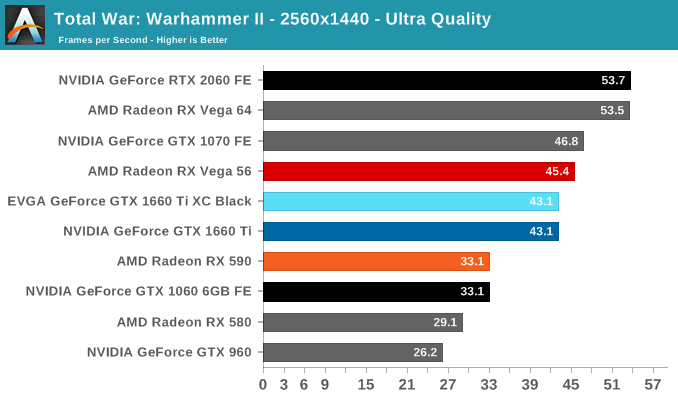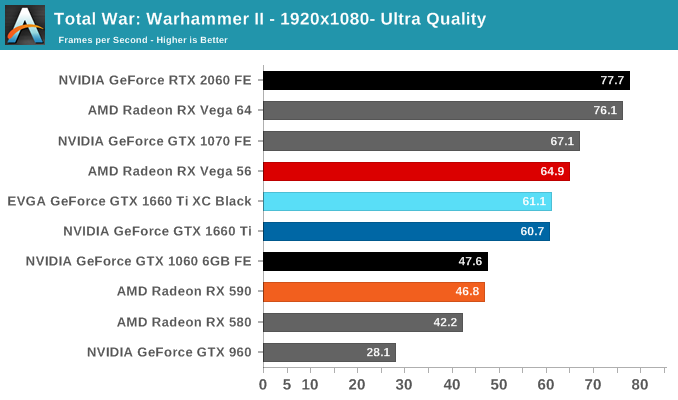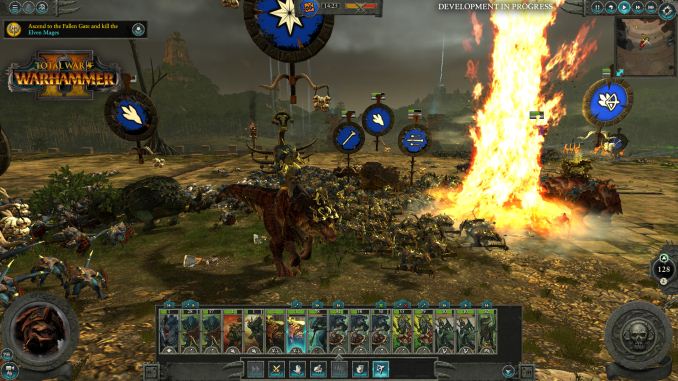The NVIDIA GeForce GTX 1660 Ti Review, Feat. EVGA XC GAMING: Turing Sheds RTX for the Mainstream Market
by Ryan Smith & Nate Oh on February 22, 2019 9:00 AM ESTTotal War: Warhammer II (DX11)
Last in our 2018 game suite is Total War: Warhammer II, built on the same engine of Total War: Warhammer. While there is a more recent Total War title, Total War Saga: Thrones of Britannia, that game was built on the 32-bit version of the engine. The first TW: Warhammer was a DX11 game was to some extent developed with DX12 in mind, with preview builds showcasing DX12 performance. In Warhammer II, the matter, however, appears to have been dropped, with DX12 mode still marked as beta, but also featuring performance regression for both vendors.
It's unfortunate because Creative Assembly themselves have acknowledged the CPU-bound nature of their games, and with re-use of game engines as spin-offs, DX12 optimization would have continued to provide benefits, especially if the future of graphics in RTS-type games will lean towards low-level APIs.
There are now three benchmarks with varying graphics and processor loads; we've opted for the Battle benchmark, which appears to be the most graphics-bound.


Rounding out our look at game performance is Total War: Warhammer II.
Here, the GTX 1660 Ti lags behind the RTX 2060 and GTX 1070 FE more than in the other games, offering only somewhere around 80% of the RTX 2060 speed and 90% of the GTX 1070. In turn, it doesn't improve as much upon the GTX 1060 6GB and GTX 960, though practically speaking it has rendered its RX 590 competition as last-generation performance, given that it's neck-and-neck with the GTX 1060 6GB FE.











157 Comments
View All Comments
Yojimbo - Saturday, February 23, 2019 - link
My guess is that in the next (7 nm) generation, NVIDIA will create the RTX 3050 to have a very similar number of "RTX-ops" (and, more importantly, actual RTX performance) as the RTX 2060, thereby setting the capabilities of the RTX 2060 as the minimum targetable hardware for developers to apply RTX enhancements for years to come.Yojimbo - Saturday, February 23, 2019 - link
I wish there were an edit button. I just want to say that this makes sense, even if it eats into their margins somewhat in the short term. Right now people are upset over the price of the new cards. But that will pass assuming RTX actually proves to be successful in the future. However, if RTX does become successful but the people who paid money to be early adopters for lower-end RTX hardware end up getting squeezed out of the ray-tracing picture that is something that people will be upset about which NVIDIA wouldn't overcome so easily. To protect their brand image, NVIDIA need a plan to try to make present RTX purchases useful in the future being that they aren't all that useful in the present. They can't betray the faith of their customers. So with that in mind, disabling perfectly capable RTX hardware on lower end hardware makes sense.u.of.ipod - Friday, February 22, 2019 - link
As a SFFPC (mITX) user, I'm enjoying the thicker, but shorter, card as it makes for easier packaging.Additionally, I'm enjoying the performance of a 1070 at reduced power consumption (20-30w) and therefore noise and heat!
eastcoast_pete - Friday, February 22, 2019 - link
Thanks! Also a bit disappointed by NVIDIA's continued refusal to "allow" a full 8 GB VRAM in these middle-class cards. As to the card makers omitting the VR required USB3 C port, I hope that some others will offer it. Yes, it will add $20-30 to the price, but I don't believe I am the only one who's like the option to try some VR gaming out on a more affordable card before deciding to start saving money for a full premium card. However, how is VR on Nvidia with 6 GB VRAM? Is it doable/bearable/okay/great?eastcoast_pete - Friday, February 22, 2019 - link
"who'd like the option". Google keyboard, your autocorrect needs work and maybe some grammar lessons.Yojimbo - Friday, February 22, 2019 - link
Wow, is a USB3C port really that expensive?GreenReaper - Friday, February 22, 2019 - link
It might start to get closer once you throw in the circuitry needed for delivering 27W of power at different levels, and any bridge chips required.OolonCaluphid - Friday, February 22, 2019 - link
>However, how is VR on Nvidia with 6 GB VRAM? Is it doable/bearable/okay/great?It's 'fine' - the GTX 1050ti is VR capable with only 4gb VRAM, although it's not really advisable (see Craft computings 1050ti VR assessment on youtube - it's perfectly useable and a fun experience). The RTX 2060 is a very capable VR GPu, with 6gb VRAm. It's not really VRAM that is critical in VR GPU performance anyway - more the raw compute performance in rendering the same scene from 2 viewpoints simultaneously. So, I'd assess that the 1660ti is a perfectly viable entry level VR GPU. Just don't expect miracles.
eastcoast_pete - Saturday, February 23, 2019 - link
Thanks for the info! About the miracles: Learned a long time ago not to expect those from either Nvidia or AMD - fewer disappointments this way.cfenton - Friday, February 22, 2019 - link
You don't need a USB C port for VR, at least not with the two major headsets on the market today.